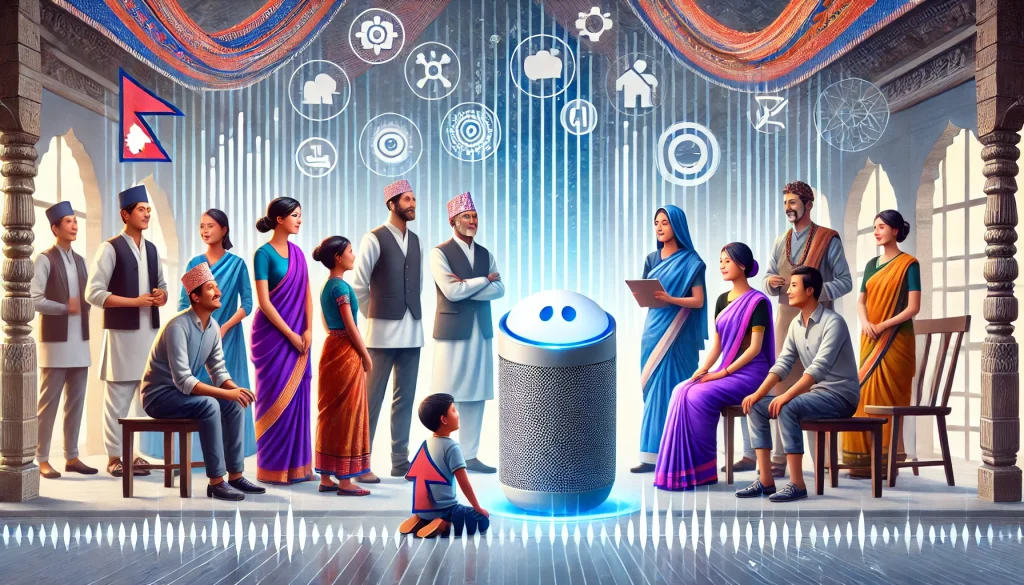An exciting development for Nepali speakers worldwide, ChatGPT has introduced the availability of voice conversations in the Nepali language. This innovative feature is set to bring AI-powered conversational technology closer to the hearts of millions of Nepali speakers, allowing them to communicate naturally and seamlessly using their native language.
च्याटजीपीटी भ्वाइस कसरी सुरु गर्ने?
1. डाउनलोड गर्नुहोस् – मोबाइल वा ट्याब्लेटमा च्याटजीपीटी एप डाउनलोड गर्नुहोस्। (App Store वा Google Play Store बाट)
2. लगइन गर्नुहोस्: – आफ्नो खाता लगइन गर्नुहोस्, वा नयाँ खाता बनाउनुहोस्।
3. सेटिङ्गमा जानुहोस्: – “सेटिङ्ग” आइकनमा क्लिक गर्नुहोस्।
4. भ्वाइस फिचर Enable गर्नुहोस्: – “भ्वाइस फिचर” छान्नुहोस् र यसलाई “अन” गर्नुहोस्।
5. माइक्रोफोन अनुमति दिनुहोस्: – एपलाई माइक्रोफोन प्रयोग गर्न अनुमति दिनुहोस्।
6. कुराकानी सुरु गर्नुहोस्: – अब “माइक” आइकन थिचेर आफ्नो प्रश्न सोध्नुहोस्।
अन्त्यमा: च्याटजीपीटीले तपाईँको प्रश्नको जवाफ भ्वाइसमा दिन्छ।
With this new voice interaction capability, users can now converse with ChatGPT in Nepali as if they were having a real-life conversation. This advancement caters to a wider audience, including those who prefer speaking over typing or have limited experience with digital interfaces. The new feature aims to enhance accessibility, enabling a more inclusive and interactive experience for Nepali-speaking individuals.
The introduction of voice conversations in Nepali also opens up possibilities in various fields, such as education, customer service, and tourism. Students can seek explanations for difficult topics, travelers can get real-time assistance, and businesses can use ChatGPT to communicate with their customers in Nepali more effectively. This enhanced communication capability will help bridge the digital gap, ensuring more people have access to the benefits of artificial intelligence.
ChatGPT’s voice feature in Nepali utilizes advanced speech recognition and natural language processing technologies, allowing the system to understand and respond accurately to spoken Nepali. By supporting this widely spoken South Asian language, ChatGPT aims to promote digital inclusion and empower more people to utilize AI in their daily lives, regardless of linguistic background.
This milestone is part of ChatGPT’s ongoing commitment to expanding its multilingual capabilities. With this addition, Nepali speakers can now enjoy a richer, more interactive experience that feels personal and culturally relevant. Whether it’s to answer questions, assist with daily tasks, or simply engage in conversation, ChatGPT’s voice feature in Nepali is transforming how people connect with technology.
The rollout of the Nepali voice conversation feature is a significant step towards a more inclusive AI ecosystem. It empowers users to speak in the language that feels most natural to them, making technology accessible to everyone, one conversation at a time.
How to Start a Conversation in Nepali
Starting a conversation in Nepali with ChatGPT is simple and easy. Just press the microphone button and say, “नमस्ते, मसँग कुरा गर्न चाहनुहुन्छ?” (Namaste, ma sanga kura garna chahanuhunchha?). This greeting will let the AI know that you are ready to engage in a conversation. You can ask questions, seek assistance, or simply chat, and the AI will respond accordingly in fluent Nepali.
Do’s and Don’ts for Voice Conversations in Nepali
Do’s:
- Speak Clearly: Ensure that you speak slowly and clearly for the AI to understand your words accurately.
- Use Simple Language: Try to use straightforward words and phrases to enhance understanding.
- Pause When Necessary: Give a brief pause between sentences to allow the system to process your input effectively.
Don’ts:
- Avoid Slang or Local Dialects: The AI might have difficulty understanding regional slang or dialects that are less common.
- Do Not Overlap Speech: Avoid speaking over the AI’s responses, as this may cause confusion in processing.
- Avoid Excessive Background Noise: Speak in a quiet environment to minimize background noise, which can affect the accuracy of speech recognition.


Good
Thank you
To talk
Talk